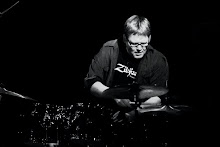I recently played a couple of wonderful nights with Peter Hum's quartet at the Rex, and Kenji Omae, our great Tenor Sax player, filmed one of Peter's new compositions, Radical Acceptance. I thought I would post a chart of the composition as well as the video and I would go through how I approached playing this tune.
Here's the PDF
Probably the most important thing to mention is the form.It's quite interesting because on the in head the from is ABCD and then E is Tenor and Guitar trading over the solo chord changes. Then when they cue us we play the tune in the reverse order (DCBA) and ends with the piano vamp it starts with. So it's got this great construction that I would liken to a flower that opens in the morning, blooms all day, and then closes its petals at the end of the day. The fact that I'm referring to a composition this way may sound "flowery" , but I often find imagery can help me conceptualize a piece and figure out how to approach it. So basically, I was trying to grow and build the piece all the way to the end of the solo section at E and then gradually bring it back down to where it started.
As I stated, the piece starts with solo piano playing a rhythmic vamp. I basically tried to incorporate and riff around that rhythm into the groove I was playing. It also felt like I should generally play all the 8th notes in the bar with my right hand, to give it some drive. Also, on reflection, it sounds a little far on top of the beat for my taste, but it least it feels exciting!
This generally goes well. Then we get to D. During that section (with the 3 bar phrases) Peter wanted it to have a little more space. I am also generally filling in the 3rd measure of all those phrases. Then I make my first error! I missed the repeat at D and went back to more of a groove again the 2nd time. But I played the figures as well and I don't think anyone was the wiser, although it made letter D slightly less effective. (I assure you, these sort of things happen all the time. The trick is to cover for them as smoothly as possible.)
Then we go on to E which has tenor and guitar playing the melody before they start trading phrases over the same chords for the solo section. I bring the volume and density down into this section to give some room for it to grow. I start off the solo section relatively quiet and playing mainly short sounds and avoid cymbals to create more space for the tenor and guitar. At around 2:22 I go back to the groove I was playing at the beginning but with the intend of gradually getting busier and louder as the solos go on. Shortly after this I turn the snares on the snare drum (for the first time in this tune) to further build the energy. As the solo section goes on, I'm filling more and playing more soloistically, even as I am still listening to the tenor/guitar and supporting them with the groove. Eventually, I settle into a bit of a pseudo-backbeat sort of thing, (around 3:30) because it feels like a good way to add energy and drama. As the trades get shorter I'm also trying to keep building. With soloists this strong, it's easy to "run out of gas" chops-wise, so it's good to take one's time building volume and density. At around 5:16, I mistakenly think letter D has been cued, when it's actually the ensemble section at letter E instead. Again, I adjust and move on. Nobody's perfect! :) When we do get to letter D, my volume has already dropped somewhat, as I'm trying to take us back to the sparse quite sound we had at the top of the tune. I then go back to my original groove and keep bringing it down by going to the hi-hat, also keeping the backbeat on the cross stick to keep the urgency up while still coming down dynamically, finally going to the side of the cymbal with the right hand to bring it down even more to the end.
I hope you find this helpful. It's great to get a chance to interpret someone's original music. It often can be less intimidating than playing standard tunes that have been played spectacularly by geniuses many times! :) Feel free to try multiple ways of interpreting a tune. There are always options and it sometimes may take a bit of trial and error to find the way that works for you. As always, have fun and be good to yourselves. :)

No comments:
Post a Comment